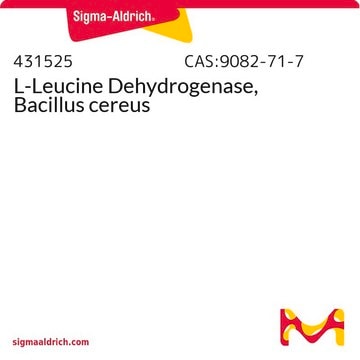L5135
L-Leucine Dehydrogenase from Bacillus cereus
lyophilized powder, ≥60 units/mg protein
Synonym(s):
L-Leucine:NAD+ oxidoreductase (deaminating)
Sign Into View Organizational & Contract Pricing
All Photos(1)
About This Item
CAS Number:
MDL number:
UNSPSC Code:
12352204
NACRES:
NA.54
Recommended Products
form
lyophilized powder
Quality Level
specific activity
≥60 units/mg protein
mol wt
245 kDa
storage temp.
−20°C
Looking for similar products? Visit Product Comparison Guide
General description
L-Leucine Dehydrogenase is a member of the amino acid dehydrogenase family.
Application
L-Leucine Dehydrogenase from Bacillus cereus has been used to determine the branched-chain amino acids (BCAA) spectrophotometrically in serum samples.
Biochem/physiol Actions
Leucine Dehydrogenase is a nicotinamide adenine dinucleotide hydrogen (NADH)-dependent oxidoreductase. It is involved in catalyzing the reductive amination of aliphatic 2-oxo-acids to their respective L-amino acids.
Unit Definition
One unit will convert 1.0 μmole of L‑leucine to α-ketoisocaproate per min at pH 10.5 at 37 °C.
Other Notes
contains lysine
Storage Class Code
11 - Combustible Solids
WGK
WGK 3
Flash Point(F)
Not applicable
Flash Point(C)
Not applicable
Personal Protective Equipment
dust mask type N95 (US), Eyeshields, Gloves
Certificates of Analysis (COA)
Search for Certificates of Analysis (COA) by entering the products Lot/Batch Number. Lot and Batch Numbers can be found on a product’s label following the words ‘Lot’ or ‘Batch’.
Already Own This Product?
Find documentation for the products that you have recently purchased in the Document Library.
Junping Zhou et al.
Biotechnology journal, 14(3), e1800253-e1800253 (2018-07-28)
Unnatural amino acids (UAAs) play a key role in modern medicinal chemistry such as small molecules and peptide-based drugs with fast-growing markets. Low efficiency for natural enzymes including leucine dehydrogenase (LeuDH, EC1.4.1.9) are one major challenge for UAA production. Here
M B Ansorge et al.
Biotechnology and bioengineering, 68(5), 557-562 (2000-05-08)
A method for the production of recombinant L-leucine dehydrogenase from Bacillus cereus in pilot scale is described employing the temperature induced runaway replication vector pIET98 and the Escherichia coli host strain BL21. Fed-batch cultivation using a semi-synthetic high-cell densitiy medium
Peng-Hu Zhang et al.
Sheng wu gong cheng xue bao = Chinese journal of biotechnology, 23(2), 268-272 (2007-04-28)
The purification and the characteristics of an enzyme from Morganella morganii J-8, which could produce d-pseudoephedrine from 1-phenyl-2-methylamine-acetone, were performed in this study. In this research, first, cells were disrupted by ultrasonic treatment at 4 degrees C. The carbonyl enantioselective
Tatyana A Muranova et al.
Acta crystallographica. Section D, Biological crystallography, 58(Pt 6 Pt 2), 1059-1062 (2002-05-31)
Leucine dehydrogenase is an octameric enzyme which belongs to the superfamily of amino-acid dehydrogenases and catalyses the reversible oxidative deamination of leucine to 2-ketoisocaproate, with the corresponding reduction of the cofactor NAD(+). Catalysis by this enzyme is thought to involve
Hongmei Li et al.
Applied biochemistry and biotechnology, 158(2), 343-351 (2008-07-16)
Although an X-ray model sequence of a leucine dehydrogenase from Bacillus sphaericus ATCC4525 was reported, the amino acid sequence of this enzyme has not been confirmed. In the current study, this leucine dehydrogenase gene was cloned, sequenced, and over-expressed in
Our team of scientists has experience in all areas of research including Life Science, Material Science, Chemical Synthesis, Chromatography, Analytical and many others.
Contact Technical Service






